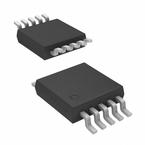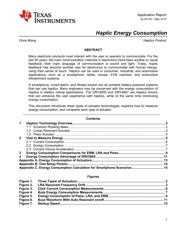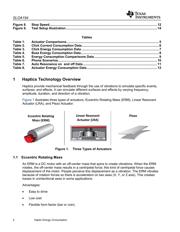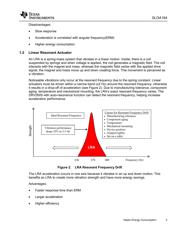herunterladen

Application Report
SLOA194 – May 2014
1
Haptic Energy Consumption
Flora Wang Haptics Product
ABSTRACT
Many electronic products must interact with the user or operator to communicate. For the
last 40 years, the main communication methods in electronics have been audible or visual
feedback; their main language of communication is sound and light. Today, haptic
feedback has become another way for electronics to communicate with human beings,
using their sense of touch. Haptics can be used in consumer, industrial, and automotive
applications, such as a smartphone, tablet, mouse, ATM machine, and automotive
infotainment systems.
A smartphone, smart-watch, and fitness tracker are all portable battery-powered systems
that can use haptics. Many engineers may be concerned with the energy consumption of
haptics in battery critical applications. The DRV2605 and DRV2667 are haptics drivers
that can enhance the user experience with haptics, while at the same time minimizing
energy consumption.
This document introduces three types of actuator technologies, explains how to measure
energy consumption, and compares each type of actuator.
Contents
1 Haptics Technology Overview ..................................................................................................... 2
1.1 Eccentric Rotating Mass ......................................................................................................... 2
1.2 Linear Resonant Actuator ....................................................................................................... 3
1.3 Piezo Actuator ........................................................................................................................ 4
2 How to Measure Energy ............................................................................................................... 5
2.1 Current Consumption .............................................................................................................. 6
2.2 Energy Consumption .............................................................................................................. 7
2.3 Current Versus Acceleration ................................................................................................... 7
3 Energy Consumption Comparisons for ERM, LRA and Piezo................................................... 9
4 Energy Consumption Advantage of DRV2605 .......................................................................... 11
Appendix A. Energy Consumption of Actuators .............................................................................. 13
Appendix B. Test Setup Picture ........................................................................................................ 14
Appendix C. Energy Consumption Calculation for Smartphone Scenarios .................................. 15
Figures
Figure 1. Three Types of Actuators ................................................................................................ 2
Figure 2. LRA Resonant Frequency Drift ....................................................................................... 3
Figure 3. Click Current Consumption Measurements ................................................................... 6
Figure 4. Buzz Energy Consumption Measurements .................................................................... 7
Figure 5. Energy Consumption of Piezo, LRA, and ERM .............................................................. 9
Figure 6. Buzz Waveform With Auto Resonant on/off................................................................. 11
Figure 7. Startup Speed ................................................................................................................ 12








